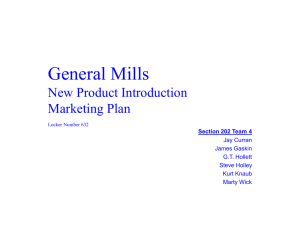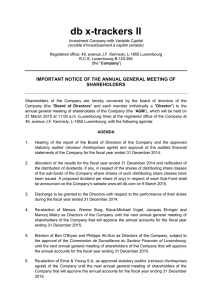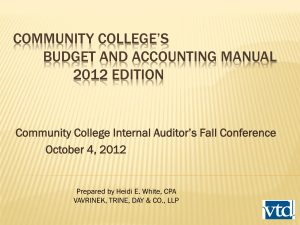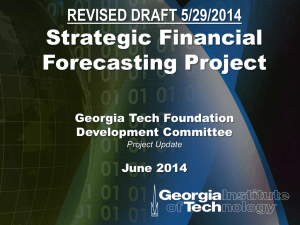Multi-Year Fiscal Planning
advertisement
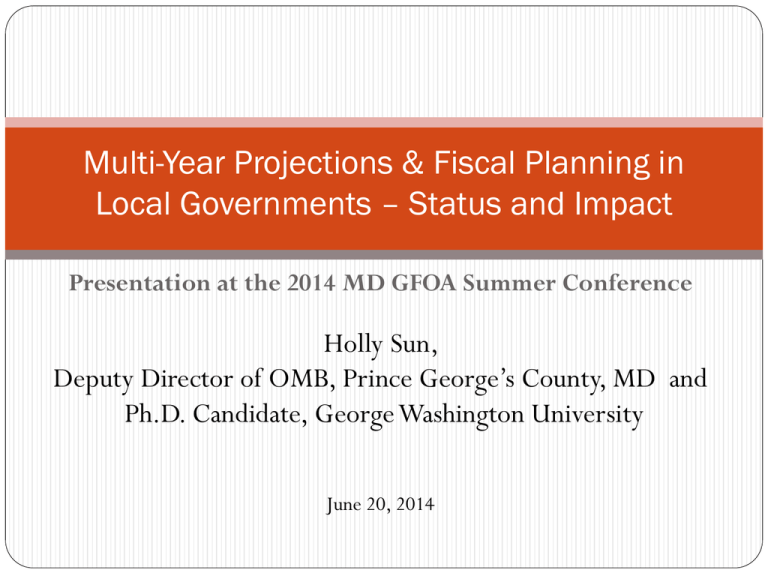
Multi-Year Projections & Fiscal Planning in Local Governments – Status and Impact Presentation at the 2014 MD GFOA Summer Conference Holly Sun, Deputy Director of OMB, Prince George’s County, MD and Ph.D. Candidate, George Washington University June 20, 2014 Background “State and local government sector continues to face near-term and long-term fiscal challenges that grow over time.” - GAO projections in April 2012 A long-range fiscal planning framework and has been advocated by professional organizations as a promising approach/tool GFOA: “long-term financial planning” World Bank: “medium-term expenditure framework” (MTEF) Limited information on the actual practice among local governments 2 Questions Are multi-year fiscal planning and projections widely used among local governments? How are they implemented? (design, process, players, etc.) Does such a practice make a difference? How to make multi-year projections and fiscal planning more effective? 3 2013 Survey (Spring) Survey developed in collaboration with GFOA to study the practice and perceived impact of multi-year fiscal planning and projections among local governments with a focus on the General Fund Distributed to approximately 1,341 GFOA Distinguished Budget Presentation Award winners, with 559 responses (41.7% response rate): 537 local governments from 44 states (344 municipalities, 91 counties, and102 special districts such as schools, parks, transit authority, etc.) 2 state governments 20 local & provincial governments in Canada 4 Is Multi-Year Projections and Fiscal Planning Widely Implemented? 5 Wide Implementation More than 78% of responding governments reportedly implement multiyear projection for the General Fund. The percentages are also high for multi-year planning practices for CIP , fiscal policies, strategic planning, and other funds. 6 Comprehensive Multi-Year Frameworks Many governments use a comprehensive multi-year fiscal planning framework with multiple components – over 59% reportedly implement at least five out of the seven listed multiyear practices. 7 Increased Momentum Among the responding governments, the portion that adopts multiyear projections for the General fund has increased significantly in the past two decades. 8 How are these multi-year frameworks developed and implemented? • Design, Purpose, Players, Process, etc. 9 Comprehensiveness of Document Most of the reported multi-year projections and fiscal plans include key revenues, expenditures and projected fund balance, but less than half of them offer solutions or scenarios to address identified issues. Which of the following items are included in your multi-year projection reports or long-term fiscal plans? (Choose all that apply) Key revenue assumptions Key expenditure assumptions Expenditures by category (e.g., personnel costs) Ending fund balances Operating budget impact of CIP (e.g., maintenance cost) Expenditures by department Multi-year economic outlook Strategies to address fiscal issues identified Projection scenario(s) that close the projected budget gap Expenditures by program Sensitivity test based on different assumptions 10 93.4% 92.5% 79.6% 79.2% 56.7% 52.2% 48.9% 41.0% 34.7% 25.5% 20.1% Transparency & Communications Most projections results are presented to critical decision makers – the legislative authority (84.0%) and the executive authority (70.6%). Slightly over one fifth of the governments present projection results to five or six stakeholders; about one third share the results with three to four listed stakeholders; 44% inform only two stakeholders or less. % of Responding Governments that Present Multi-Year Projection Results to The Following Stakeholders Legislative Authority Executive Authority The Public (one-line publications) The Public (hearings/meetings) Bond Rating Agencies Collective Bargining Units 0.0% 11 20.0% 40.0% 60.0% 80.0% 100.0% Engagement in Multi-Year Projections / Planning Central budget/finance offices reported play a critical role in developing multi-year projections. Other main players include: senior management (nearly 90% of the time) individual departments (three fourth of the time) the legislative authority (slightly over 50%) Other players (citizen advisory boards, revenue/expenditure panel, etc.) are less frequently engaged. 12 Integration With Strategic Planning Close to half of the responses indicate that their multi-year expenditure projections either have no observed linkage with the government’s long-term strategic plans or are primarily driven by other factors. The rest respond that their multi-expenditure projections largely match strategic priorities by sector (e.g., public safety) – 17% Department – 26% Program – 10% 13 Key Challenges / Obstacles Lack of confidence in projections for out years Administrative burden Concerns on its usefulness Difficulty to integrate multi-year projections with long-term strategic priorities Lack of interest from the elected officials 14 Does Multi-Year Projections and Fiscal Planning Make a Difference? 15 Impact Evaluation – Framework Survey respondents asked to provide ratings (0=no impact, 1=little impact, 2=some impact and 3=significant impact) on multi-year fiscal planning’s effect on improving five aspects: • • • • • Fiscal discipline and long-term fiscal sustainability Allocation efficiency (match strategic priorities) Operation efficiency Agencies’ involvement Transparency / Citizens’ understanding Note: the five aspects are primarily based on the framework used by the World Bank and IMF to assess the effectiveness of MTEFs and public finance management 16 Effectiveness Perceived High • In particular, 90% responses indicate that multi-year fiscal framework has an impact on fiscal health, and 60% believe this impact is “significant” Impact Evaluation of Multi-Year Fiscal Planning and Projections Improve fiscal discipline & long-term fiscal sustainability Improve expenditure prioritization (match strategic priorities) Improve departments' involvement in budget development Improve efficiency (reduce cost per unit of services) Improve citizens' understanding of budget and policies 0% No Impact 17 Minor Impact 20% 40% Some Impact 60% 80% Significant Impact 100% How To Make Multi-Year Projections and Fiscal Planning More Effective? • Survey Responses • Statistical Analysis Results 18 Strong Purpose and Clear Targets Multi-year projections and fiscal planning is designed to not only inform on trend and issues, but also to help achieve clearly identified fiscal/strategic policy goals, such as: Certain fund balance level A structurally balanced budget Improved performance on priority services 19 Quality Projections and Presentation Quality – Accuracy, Comprehensiveness, and Simplicity Engage stakeholders and experts to improve projection accuracy Include detailed assumptions, analysis and implications Use graphs and bullets to deliver key messages Strategies / options / scenarios needed Showing strategies / options to address the predicted fiscal issues is critical to facilitating candid dialogues among key stakeholders regarding tradeoffs between options and consensus building 20 Integration Projections/plan closely reflects multi-year strategic priorities rather than showing a status quo scenario alone Collaboration and Transparency Involve key players in the development of multi-year projections/plan development to improve: quality of the projections understanding of fiscal outlook consensus building on priorities Communicate results of the multi-year projection results with key stakeholders Facilitate strategic discussions for understanding and decisions 21 Integration with the Annual Budget Present multi-year projections to the legislative authority (Council) before or during the annual budget reviews Make the multi-year fiscal outlook and planning an official component of the annual budgeting process On-going modifications, evaluation and follow-up 22 Summary of Success Factors Survey Reponses Quality of multi-year Comprehensiveness of the multi-year 23 Statistical Analysis Results forecasting On-going modifications, evaluation and follow-up Multi-year projections made an official component of the annual budgeting process Support or buy-in of elected officials Collaborative approach projection/planning materials Strategies / Options included Multi-year projections/planning designed to achieve a structurally balanced budget or certain level of fund balance Integration between projections and multiyear strategic priorities at a detailed level Multi-year projections are presented to the legislative authority (council) before or during the annual budgeting reviews Engage more players in developing multiyear projections Projection results are presented to more stakeholders Conclusion Multi-year Projections and Fiscal Planning can be an effective policy tool that helps improve decision making and fiscal health Its success lies in the fundamentals (e.g., the quality of projections and presentation materials) as well as its ability to inform decision makers and facilitate candid dialogue among key stakeholders regarding priorities and strategies to reach policy goals in a multi-year framework Certain factors (purpose, comprehensiveness, collaboration, integration level, etc.) prove to be critical to its effectiveness 24 Reference and Contact More details regarding findings from the survey can be found in an article by Holly Sun (“Improving the Effectiveness of Multi-Year Fiscal Planning”) published on Government Finance Review, February 2014 Feedbacks, questions, and experiences to share… are welcome Contact: hsun@co.pg.md.us or holly.w.sun@gmail.com 25


